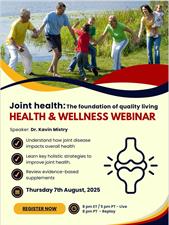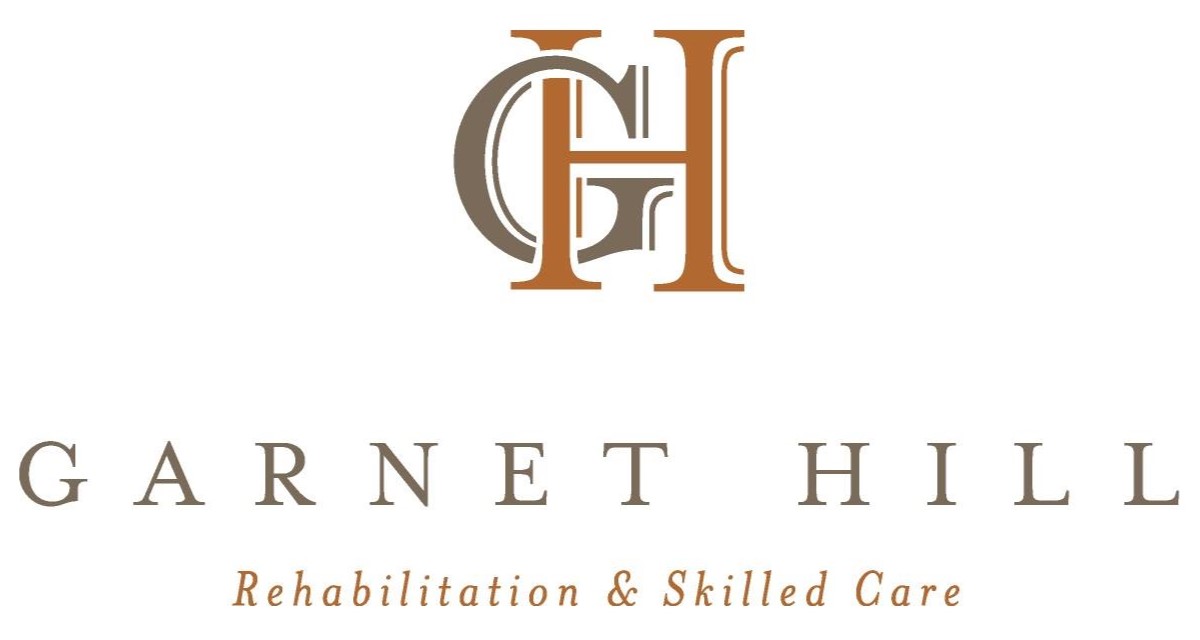HEALTH & WELLBEING SEMINAR: Joint Health

Date and Time
Thursday Aug 7, 2025
7:00 PM - 8:00 PM CDT
Aug 7th, 2025 : 7pm - 8pm
Location
Zoom Registration Link:
https://us06web.zoom.us/meeting/register/zmthCyIvTtmrm52mic2rOg#/registration
Fees/Admission
Free
Website
https://www.linkedin.com/pulse/joint-health-foundation-quality-living-kavin-mistry-md-jkbbe/
Contact Information
Priyanka Shivpuri
Send Email

Description
Joint Health: The Foundation of Quality Living
Joint disease is a major driver of disability in the United States. Osteoarthritis remains the most prevalent form of arthritis and is a leading cause of reduced quality of life in older adults. Studies show that patients with osteoarthritis report significantly poorer general, physical, and mental health, along with impaired sleep and increased activity limitations. Knee pain, climbing stairs, and morning stiffness rank among the highest indicators of disability in these patients.
The impact is not limited to physical symptoms. Osteoarthritis undermines mobility, mood, social engagement, independence, and work productivity. That makes joint health one of the most critical elements in designing a life that remains active, joyful, and meaningful.
Key Joints Under Pressure: Knees, Hips, and Shoulders
Knees support the weight of everyday life. Knee osteoarthritis is the most common reason for joint replacement surgery. Patients often experience pain, impaired mobility, higher fall risk, and reduced capacity for routine tasks.
Hips enable upright posture, walking, and balancing. When hip joints degenerate, stride length shortens and gait is affected, increasing the risk of falls and daily functional decline.
Shoulders provide lifting, reaching, and rotation. Damage to rotator cuff muscles or joint cartilage causes pain, stiffness, sleep disruption, and limitations in tasks such as reaching overhead.
When these three joints are compromised, simple actions such as bending, walking, or lifting become difficult. Over time, this restriction leads to a lower mood, reduced social activity, decreased independence, and a diminished sense of joy in life.
Holistic Principles for Strong Joints
1. Move every day, with intention. Low-impact movements, such as walking, cycling, swimming, and yoga, foster joint lubrication and improved circulation. Muscle strengthening around joints helps stabilize and protect them.
2. Maintain a healthy weight. Every extra pound adds stress to knee and hip joints and contributes to systemic inflammation through fat tissue. Even moderate weight loss can reduce pain and improve function.
3. Prioritize sleep and mental resilience. Poor sleep, chronic stress, and low mood can exacerbate inflammation and increase pain sensitivity. Practices such as meditation, breathwork, and structured sleep routines support recovery and reduce the inflammatory load.
4. Follow an anti-inflammatory diet. A Mediterranean-style approach rich in fatty fish, olive oil, leafy vegetables, berries, and nuts offers nutrients and antioxidants that support joint tissues and reduce systemic inflammation.
5. Improve mechanics with targeted strength. Physical therapy can help correct gait, alignment, and movement patterns to improve overall mobility. Strengthening the glutes, hip stabilizers, quadriceps and hamstrings, rotator cuff, and scapular muscles reduces joint strain.
6. Use daily tasks as movement training. Walking meetings, carrying groceries, using stairs, and taking mobility pauses help add functional strength and variety of movement to everyday life.
Evidence-Based Supplements for Joint Comfort
Supplements should be considered only after foundational habits of movement, nutrition, and recovery are established.
Omega-3 fatty acids (EPA/DHA)
Strong anti-inflammatory properties have been shown to reduce joint tenderness, morning stiffness, and pain, particularly in osteoarthritis and inflammatory arthritis.
Glucosamine sulfate
A precursor in cartilage formation, commonly taken at 1,500?mg per day. Results across trials diverge. Meta-analyses suggest only small to modest benefit, if any, and effects may vary by formulation (sulfate vs hydrochloride).
Chondroitin sulfate
Often used in combination with glucosamine. Some short-term benefits in pain and stiffness have been observed, but high-quality trials show minimal or inconsistent symptomatic relief. Significant structural improvement is not reliably demonstrated.
Boswellia serrata extract
Active compounds such as AKBA inhibit inflammatory pathways. Clinical studies have reported modest improvements in pain and physical function in osteoarthritis of the knee and hand.
Guidelines for supplement use
Choose third-party tested products, standardized dosages, and transparent sourcing. Trial these for at least 3–6 months and monitor outcomes objectively. These should never replace foundational habits in movement, weight management, sleep quality, or nutrition.
Cutting-Edge Advances in Joint Health Science
Recent scientific breakthroughs are transforming the way we approach joint degeneration and osteoarthritis. Researchers are pioneering regenerative medicine approaches, including 3D-printed cartilage scaffolds, nasal chondrocyte–based grafts, and mesenchymal stem cell (MSC) therapies, to restore injured joint tissue. A first-in-human trial using engineered cartilage from nasal chondrocytes demonstrated durable improvements in function and pain reduction in challenging knee defects. Combined cell therapies using allogeneic MSCs alongside autologous chondrons have shown promising results in improving knee mobility and reducing pain in recent clinical studies. Gene-activated bioprinted scaffolds and precision hydrogels are currently under development to deliver growth factors, such as FGF-18, IGF-1, and BMPs, directly into damaged cartilage regions, thereby enhancing chondrocyte survival and extracellular matrix formation. At the same time, emerging treatments such as gene therapy targeting the interleukin-1 receptor antagonist and sprifermin (recombinant FGF-18) show early promise in modulating anabolic and anti-catabolic pathways in osteoarthritis. Clinicians are also experimenting with minimally invasive treatments such as genicular artery embolisation (GAE), which has led to significant pain relief and improved quality of life in moderate-to-severe knee OA cases. Together these advances are paving the way toward disease-modifying osteoarthritis drugs (DMOADs) and regenerative therapies that may one day halt or reverse joint degeneration.
A Primal Plan for Lifelong Joint Strength
- Design daily movement rituals that incorporate joint mobility, functional lifting, walking, and strength training.
- Eat anti-inflammatory whole foods: fish, olive oil, colorful plants, nuts, and spices.
- Build strength where joints need it: glutes, hip abductors, quad/hamstring balance, rotator cuff, and scapula.
- Supplement judiciously: fish oil (approx. 1–3?g EPA/DHA), boswellia extract, glucosamine sulfate, chondroitin sulfate—with careful monitoring over months.
- Track meaningful markers: pain, mobility, sleep quality, mood, energy, and joy in activities.
Final Perspective
Joint disease affects millions in the U.S., causing pain, limitation, and reduced quality of life. But with intention and evidence-based action, it does not have to define aging. Healthy knees, hips, and shoulders enable confidence, social engagement, mobility, and independence.
You are not destined to slow decline. By consistently applying movement, nutrition, resilience, and targeted supplementation, you can support joint tissue, reduce inflammation, and sustain mobility. Your body remains resilient at every age.
That is true biological design.



























